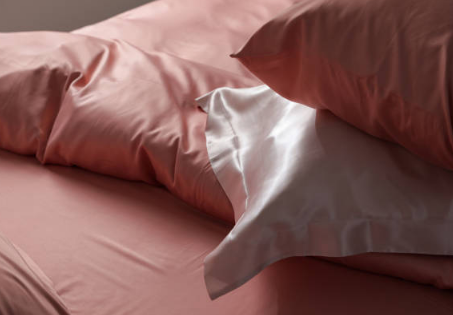Silk is a natural fiber made up of protein (like your hair), making it easier to wash than you think. Silk fibers are made from silkworm cocoons boiled in hot water until they spread out. Silk is known to be hypoallergenic and repel moths and dust mites, making it an ideal bedding for allergy and asthma sufferers. Silk is also practical for people with sensitive skin, dry skin, or eczema, helping to wick moisture away from the body and keep you cool all night long.

The luxurious touch of silk is intimidating when it comes to laundry. If your bedding is 100% silk, you can completely hand wash it at home or machine wash. We’ll also show you how to deal with stains and dry silk bedding to maintain its best appearance (and performance).
Can Silk Be Washed
Just like any other fabric that may contain bacteria, sweat, and dirt, you must wash the silk regularly to keep it fresh and germ-free. But even if your garment care label says “dry clean” or “not washable,” 100% silk garments can usually be washed at home. However, there are a few precautions you need to take to keep your silk pillowcase looking its best.
Although silk is washable, some of the dyes used to dye silk are unstable when washed. Washing silk also removes its satin surface, leaving a pebble texture. Avoid using baby soap or shampoo to treat stains. Soap is made from lye and vegetable fats, ingredients that can damage silk, leave residue, or eliminate one of the best characteristics of silk – shine.
To prevent permanent damage, be sure to perform a waterproof test and a bleeding test before washing the silk. When washing silk, the next most important thing is to choose the right laundry detergent. Choose a detergent that specializes in handling silk, such as Delicate Wash ($30, The Laundress). Chlorine bleach should never be used as it can damage or even dissolve the silk fibers.
How to Wash Silk Sheets and Pillowcases
While silk can be hand washed or machine washed, hand washing is the safest way to wash silk.
How to hand wash silk
What you’ll need:
- Sink or laundry tub/basin
- Silk detergent of your choice
- Drying racks
- Iron or steamer
Step 1: Pre-treat the odor and mix the soap solution.
If your silk pillowcases and sheets have an odor, soak the fabric in warm water mixed with 1/4 cup of white vinegar before washing. Fill a clean laundry tub or sink with cold water. Read the label recommendations and add the correct amount of detergent.
Step 2: Wash the pillowcase.
Turn the pillowcase over and submerge it in water. If washing multiple pieces of bedding, wash them only with clothing of a similar color. Gently stir water and soap with silk by hand. When the fibers are wet, the silk becomes brittle, so it should not be rubbed excessively. Do not allow the silk to soak for more than 30 minutes.
Step 3: Rinse and dry.
Rinse your belongings with cold water until all the soap has been washed away. Gently squeeze the water out of the item. Do not wring them out.
Place the silk pieces on a drying rack to dry or lay flat on a surface. Avoid using hangers with metal clips as this can damage the fabric. Padded or flocked hangers work best. Silk wrinkles after washing. Follow the steps below for us to dry and store silk to remove wrinkles.

How to machine wash silk
What you’ll need:
- Delicate detergent
- Mesh laundry bags
- Drying racks
- Hand iron or steam iron
Step 1: Select machine settings and temperature.
Look for the silk loop option on the washing machine. If not, use the fine loop, which is the equivalent of a hand-washing machine. Silk is more susceptible to tearing (and wrinkling) in fast spin cycles, which is why fine loops work best. The safest way to machine wash silk is to rotate at low speed or not at all and with the shortest cycle. Make sure the water temperature is low and the rotation speed is low.
Step 2: Put it in a laundry bag and wash it.
Wash silk separately from everyday clothing, and do not wash silk with cotton clothing or towels. In addition, it should only be washed with clothes of a similar color. When washing silk pillowcases, place smaller items in a mesh laundry bag to prevent tearing.
Step 3: Remove from the washing machine and allow to dry.
Immediately after the cycle is over, the silk pieces are removed from the washing machine. Do not allow the silk to soak for more than 30 minutes. Place silk clothes on drying racks to dry or lay flat, avoiding hangers with metal clips. Once dry, silk may wrinkle, and below we will show you how to remove wrinkles.
How to Clean Silk Pillowcase Stains
Desoiling silk can leave larger stains that can permanently damage the fabric. For stains on silk pillowcases or bed sheets, first treat the affected area with a stain solution specific to silk fabrics. Use your fingers or brush to gently wipe away the stain with cold water and stain remover. Do not rub or pull on the stains on the silk, as this may damage the fragile material. Finally, wash the item using one of the above methods.
Important: Don’t forget to wash your pillow every few months. Pillows can contain bacteria, dust, dirt, and sweat that can accumulate over time.
How to Dry and Store Silk
Regardless of how you choose to wash your silk pillowcase, never put any silk products in the dryer. Also, do not dry silk in direct sunlight. Both options darken and shrink the silk.
Handheld steam ironers work well to remove wrinkles from silk because the material is soft and does not require a traditional iron. If ironing, use the lowest iron temperature and place a pressed cloth between the silk goods and the iron.
Store silk items on hangers or in hanging storage bags to prevent them from yellowing, dust, and pests. These processes are also applicable to silk garments.
How Often Should Silk Pillowcases Be Washed
While silk bedding naturally wicks away dust and dirt (so it doesn’t need to be washed as often), you should treat silk pillowcases and sheets like any other bedding and never mix them with towels. It is recommended to wash the sheets and duvet covers once a week, or replace them with a new, clean set of sheets at least every 10 days. Wash as described above and make sure to replace the silk pillowcase once a year – the delicate nature of silk means that this product has a shorter lifespan than other bedding fabrics.